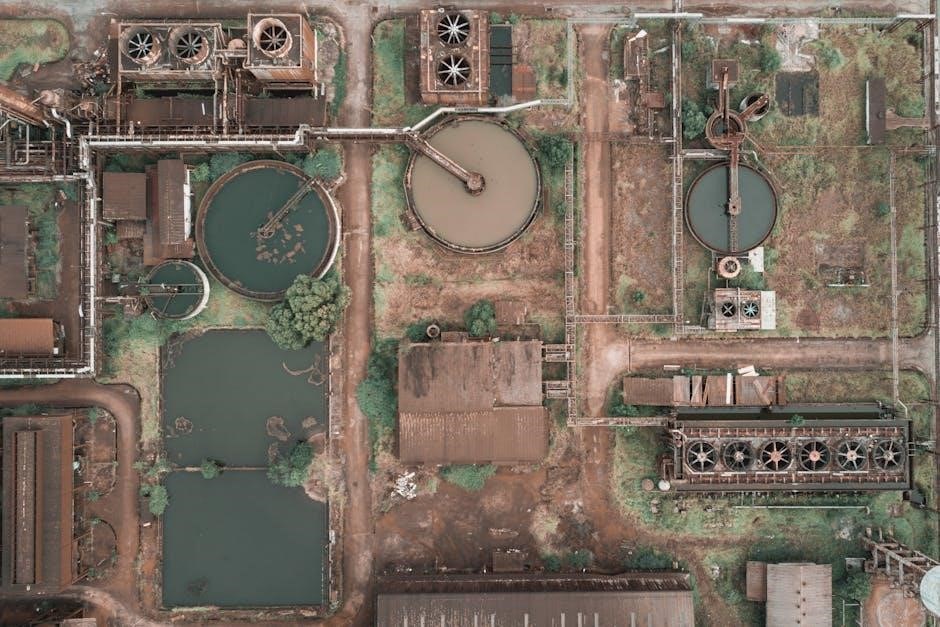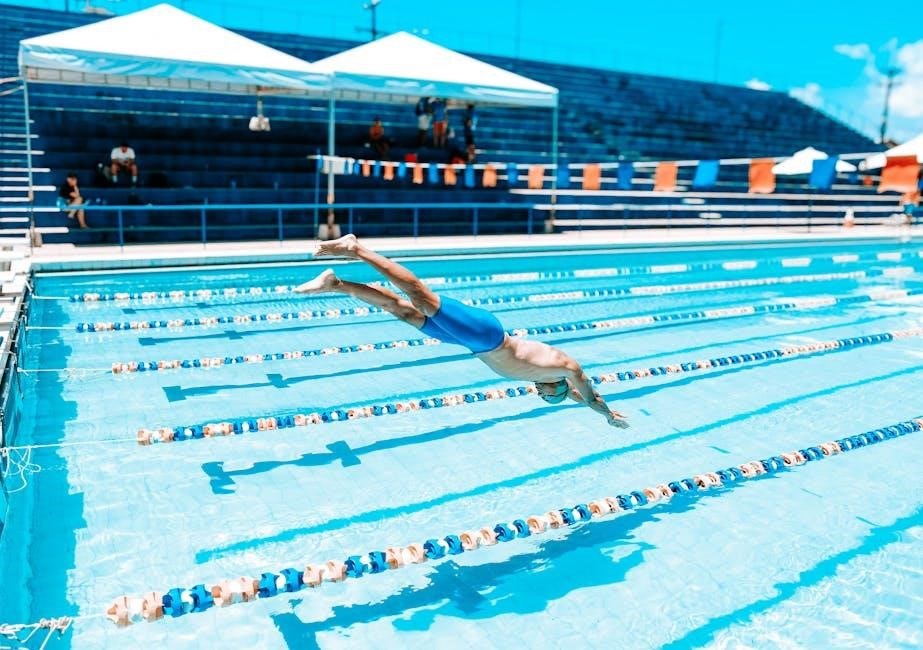
Proper pool filter sizing is crucial for maintaining clean water and efficient circulation; It depends on pool size, shape, and usage. Oversized or undersized filters can lead to poor performance. This guide helps you navigate the process, ensuring optimal filtration and water quality for safe and enjoyable swimming experiences.
Calculating Pool Volume
Calculating pool volume is essential for sizing filters. For rectangular pools, use: Length × Width × Depth × 7.5. Circular pools: 3.14 × Radius2 × Depth × 7.5. Oval pools: 5.9 instead of 7.5.
2.1. Rectangular or Square Pools
For rectangular or square pools, calculate the volume using the formula: Length × Width × Average Depth × 7.5. This gives the volume in gallons. Ensure accurate measurements, as incorrect dimensions can lead to improper filter sizing. If the pool has varying depths, use the average depth for calculations. Always double-check measurements to avoid errors. This step is critical for determining the correct flow rate and filter capacity. Accurate volume calculation ensures efficient filtration and optimal water circulation. Refer to manufacturer guidelines for specific sizing requirements based on your pool’s volume.
2.2. Round or Circular Pools
For round or circular pools, calculate the volume using the formula: 3.14 × Radius² × Depth × 7.5. Measure the radius accurately, as small errors can affect the result. If the pool has varying depths, calculate the average depth. Precise measurements are essential to ensure proper filter sizing. Use a pool volume calculator if available for convenience. Accurate volume calculation is critical for determining the correct flow rate and filter capacity. This ensures efficient filtration and optimal water circulation. Always verify calculations to avoid undersizing or oversizing the filter system.
2.3. Oval Pools
For oval pools, calculating volume requires a slightly different approach. Use the formula: Length × Width × Average Depth × 5.9. This adjustment accounts for the oval shape’s unique dimensions. Measure the longest and widest points for accurate calculations. If the pool has variable depths, calculate the average by adding the shallowest and deepest points and dividing by two. Precise measurements ensure proper filter sizing. Unlike circular pools, oval pools use a lower multiplier to avoid overestimating volume. This method ensures the correct flow rate and turnover time for optimal filtration efficiency and water clarity.

Understanding Filter Types
Pool filters come in three main types: cartridge, sand, and diatomaceous earth (DE). Each offers unique benefits and maintenance requirements, catering to different pool sizes and user preferences.
3.1. Cartridge Filters
Cartridge filters are popular for their efficiency and ease of maintenance. They use replaceable cartridges with varying sizes and capacities, such as the Unicorn FCFE 10, which offers 10×2½ dimensions and 8,000-liter capacity. These filters are ideal for pools requiring lower flow rates, typically up to 6 liters per minute. They are compact, easy to clean, and suitable for smaller residential pools. Replacement cartridges are widely available, making them a practical choice for pool owners seeking reliable filtration with minimal upkeep. Their design ensures high water quality, making them a versatile option for various pool setups and user preferences.
3.2. Sand Filters
Sand filters are a popular choice for pool filtration due to their reliability and low maintenance. They use silica sand, typically sized between 0.45 mm and 0.85 mm, to trap dirt and debris. Suitable for residential pools, sand filters are often sized between 300 mm and 600 mm in diameter. They are cost-effective and require backwashing periodically to maintain efficiency. Sand filters are ideal for pools with moderate flow rate needs, typically up to 105 liters per minute. Their simplicity and durability make them a practical option for homeowners seeking consistent water quality without high upkeep demands.
3.3. Diatomaceous Earth (DE) Filters
Diatomaceous Earth (DE) filters are known for their high filtration efficiency, trapping particles as small as 2-5 microns. They use DE powder, which coats filter grids to capture dirt and contaminants. DE filters are ideal for pools requiring pristine water quality but require regular maintenance, including recharging the DE media after cleaning. They are less common in large pools due to higher upkeep and lower flow rate capacities compared to sand or cartridge filters. DE filters are best suited for smaller pools or applications where superior water clarity is a priority, despite their higher maintenance demands.

Determining Flow Rate Requirements
Flow rate is calculated in gallons per minute (GPM) and depends on pool volume, desired turnover time, and system pressure. Accurate sizing ensures efficient filtration and water circulation.
4.1. Calculating Gallons Per Minute (GPM)
Calculating gallons per minute (GPM) is essential for determining the appropriate flow rate for your pool system. To find GPM, divide the total pool volume (in gallons) by the desired turnover time (in minutes). For example, if your pool holds 30,000 gallons and you want a 6-hour turnover, the calculation is 30,000 ÷ 360 minutes = 83.33 GPM. This ensures the filter can handle the water flow efficiently. Use the formula: GPM = Pool Volume (gallons) ÷ Turnover Time (minutes). Standard turnover rates are typically 4–6 hours for residential pools and 2–4 hours for commercial pools.
4.2. Understanding Feet of Head
Feet of Head measures the total resistance in a pool system, influencing pump performance. It combines static head (vertical lift), friction head (pipe resistance), and equipment head (filter, fittings). Calculate it by summing these components: total Feet of Head = static head + friction head + equipment head. Static head is the vertical distance the pump lifts water. Friction head depends on pipe length, diameter, and fittings. Equipment head includes filter and valve resistance. Match the pump’s performance curve to the calculated Feet of Head for optimal flow and efficiency. Accurate measurement ensures proper system operation and water circulation.

Manufacturer Sizing Guidelines
Always follow manufacturer sizing guidelines for accurate filter selection. Refer to NSF Standard 50 and the specs outlined by your filter’s manufacturer for optimal performance and compliance.
5.1. NSF Standard 50
NSF Standard 50 provides criteria for pool filtration systems, ensuring they meet performance, safety, and durability requirements. It evaluates filters based on flow rates, particle removal efficiency, and long-term reliability. Compliance with this standard guarantees that equipment can handle the pool’s volume effectively and maintain clean, safe water. Manufacturers must test their products to meet these rigorous guidelines, giving consumers confidence in the system’s performance. Adhering to NSF Standard 50 ensures your filter operates efficiently, supporting a healthy swimming environment for years to come.
5.2. Filter Manufacturer Specifications
Filter manufacturer specifications outline the recommended flow rates, capacities, and compatibility for various pool systems. These specs ensure the filter matches the pool’s volume, shape, and usage demands. Manufacturers provide detailed guidelines for cartridge, sand, and DE filters, including maximum flow rates and ideal pool sizes. Proper alignment with these specs ensures efficient filtration and system longevity. Always verify compatibility with your pump and plumbing setup. Factors like pool shape and additional features (e.g., waterfalls or jets) may also influence the manufacturer’s recommendations for optimal performance and maintenance. Adhering to these guidelines ensures a balanced and effective filtration system.

Sizing by Pool Type
Pool type significantly impacts filter sizing. Residential pools require smaller systems, while commercial pools demand larger, heavy-duty filters. Each type has unique volume, usage, and regulatory needs.
6.1; Residential Pools
For residential pools, filter sizing depends on pool volume, calculated using formulas like length × width × depth × 7.5 for rectangular pools. Sand filters, ranging from 300 to 600mm in diameter, are commonly recommended. Aim for a turnover rate of 8-12 hours, ensuring the filter can handle the pool’s volume effectively. Consider flow rate in gallons per minute (GPM) and ensure compatibility with the pump’s Feet of Head. Always check NSF Standard 50 guidelines and manufacturer specifications for optimal sizing. Proper sizing ensures clean water, efficient circulation, and compliance with safety standards for enjoyable swimming experiences in residential settings.
6.2. Commercial Pools
Commercial pools require larger, heavy-duty filters to handle higher bather loads and faster turnover rates. Typically, filters for commercial pools must manage at least 500 GPM or more, depending on the pool’s volume. The turnover rate is often shorter, around 4-6 hours, to maintain water quality and safety. NSF Standard 50 guidelines are critical for sizing commercial pool filters. Sand or cartridge systems are common, with materials like stainless steel or high-duty cartridges recommended for durability. Proper sizing ensures compliance with health regulations and efficient handling of high usage demands, making it essential for public and communal swimming facilities.

Special Considerations
Consider pump and pipe sizing to ensure efficient flow rates. Additional features like valves, automation, and advanced filtration media can enhance performance. Always follow NSF standards for safe water quality.
7.1. Pump and Pipe Sizing
Pump and pipe sizing are critical for efficient water circulation. The pump must match the pool’s volume and filter type to maintain optimal flow rates. Pipe diameter and length affect resistance, so proper sizing ensures minimal energy loss. Consider the total head pressure, including elevation changes and fittings. Oversized pipes reduce friction, while undersized pipes can restrict flow. Variable-speed pumps offer energy efficiency. Always consult manufacturer guidelines and NSF standards for safe and reliable system performance. Proper sizing ensures effective filtration, reduces maintenance, and extends equipment lifespan. Balance pump and pipe sizing for a seamless pool operation.
7.2. Additional Features and Upgrades
Enhancing your pool system with additional features can boost performance and convenience. Consider upgrading to energy-efficient pumps or automation systems for smarter control. Modular cartridge filters offer easy maintenance and improved flow rates. Glass filtration media is an eco-friendly alternative to sand, providing superior clarity. Advanced DE filter systems, like Aqua-Cel, simplify media addition. High-capacity cartridges, such as Unicorn FCFE, extend service intervals. Durable materials and low-maintenance designs reduce long-term costs. Upgrades like these ensure your system remains efficient, sustainable, and tailored to your pool’s needs, enhancing overall satisfaction and pool longevity.
Proper pool filter sizing is essential for maintaining clean, safe, and efficient water circulation. Oversized or undersized systems can lead to poor performance, increased costs, and reduced water quality. By understanding pool volume, flow rates, and filter types, you can make informed decisions. Always consider NSF standards and manufacturer guidelines for optimal results. Regular maintenance and upgrades, such as energy-efficient pumps or advanced filtration media, further enhance system performance. A well-sized filter ensures a cleaner, safer, and more enjoyable swimming experience. Apply these principles to create a tailored solution for your pool, ensuring long-term satisfaction and efficiency.

Additional Resources
For further guidance, explore online calculators and manufacturer websites to size filters accurately. NSF Standard 50 provides detailed criteria for pool filtration systems. Consult filter manufacturer specifications, such as those for sand, cartridge, or DE filters, to ensure compliance. Additionally, industry guides and tutorials offer step-by-step instructions for calculating pool volume, flow rates, and turnover capacity. Utilize these tools to optimize your pool’s filtration system and maintain peak performance. Always refer to trusted sources for the latest advancements in pool filter technology and best practices in system design and maintenance.